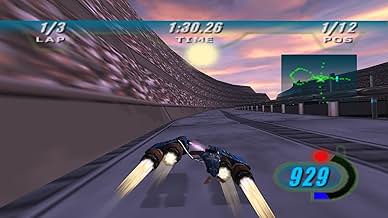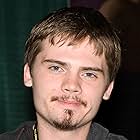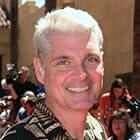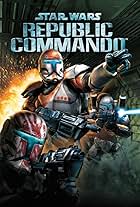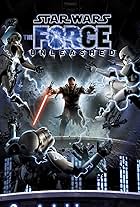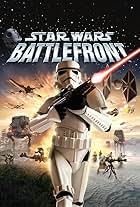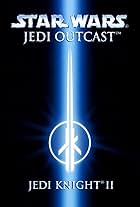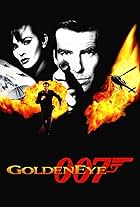IMDb RATING
7.5/10
1.3K
YOUR RATING
Compete in the galactic pod-racing championship as one of the many pod-racers featured in Star Wars: Episode I - The Phantom Menace (1999).Compete in the galactic pod-racing championship as one of the many pod-racers featured in Star Wars: Episode I - The Phantom Menace (1999).Compete in the galactic pod-racing championship as one of the many pod-racers featured in Star Wars: Episode I - The Phantom Menace (1999).
Jake Lloyd
- Anakin Skywalker
- (voice)
Andy Secombe
- Watto
- (voice)
Lewis Macleod
- Sebulba
- (voice)
Dominic Armato
- Ben Quadinaros
- (voice)
- …
Bob Bergen
- Clegg Holdfast
- (voice)
- …
Gregg Berger
- Wan Sandage
- (voice)
- …
Dave Fennoy
- Toy Dampner
- (voice)
Roger Jackson
- Ark 'Bumpy' Roose
- (voice)
- …
Nick Jameson
- Aldar Beedo
- (voice)
David Jeremiah
- Dud Bolt
- (voice)
- …
Peter Lurie
- Boles Roor
- (voice)
- …
Terence McGovern
- Ratts Tyerell
- (voice)
- (as Terry McGovern)
- …
Michael Sorich
- Mawhonic
- (voice)
- …
Storyline
Did you know
- TriviaThe game is like it shows us Anakin's life in the corredores Delaware vainas before making his debut in the first movie.
- Crazy creditsNever actively tried to sabotage the project: Tim Shaefer
Featured review
When LucasFilm's first film in the highest-grossing franchise since 1983 was screened, enthusiasm had already gathered around it to make it the best-performing movie of 1999, but filmgoers were in for a bumpy, roller-coaster ride. However, it was not quite the ride they were looking for. The track they rode on that was The Phantom Menace, the first of the three episodes set decades before Luke Skywalker's rise, had its highs and lows, the highs being the action sequences and visual effects, and the lows including attempts at humor that too often backfired, a few questionable actors reprising the roles of important characters handpicked by George Lucas, and at times the screenplay. Oh well, who is to say that movie legends last forever? At least Revenge of the Sith partly learned from its older siblings' missteps, but with heavy promotion came video game tie-ins. I confess they were not always great, but even critics grudgingly respect some good coming out of the prequels and influencing titles like Battlefront. Star Wars Episode I: Racer is the only game I can think of based entirely on a scene from one of the prequel movies that counts as a better-than-good game.
The version for Windows is what I am looking at. The game is based on the famous pod-racing sequence from the first film, one of its loop-de-loops (the other, of course, being the Duel of the Fates scene), and a real roller-coaster. From the moment it starts, everything seems to be in place. John Williams' score for The Phantom Menace returns in high fidelity, the backdrops look convincingly like shots from the movie, one of Sebulba's pod tailgating Anakin's and two of the pod hangar, and five main voice actors return to reprise their roles. After creating a profile and configuring the controls, you are ready to race in the tournament. You are then taken to a cantina that has a holographic projector used to view the game's 23 playable racers (or 25 if you count the cheat-activated model swaps) and 25 tracks. The projector is then used to select them both. At the pod selection screen, you have a good view of the characters, their pods, and their statistics, which include traction, handling, acceleration, top speed, braking, engine cooling, and the rate at which they can be repaired, the last important since the vehicles will sustain damage in ways I will explain later. The next screen is course selection. Three circuits from easy to hard are available and can be partaken in any order, although only one track is open and must be finished in fourth place or higher in order to unlock the next. A fourth circuit comprising four tracks is unlocked only after one of the other circuits is completed. You then decide the course, and you also set how the prizes are distributed among the racers who finish in the top four. One of these distributions is "winner take all", but let's be realistic. In the event you do not finish first, you can easily restart the race without any consequences. Okay, let's say you do want challenge. You can simply forgo all upgrades and still claim the championship because it turns out they are not necessary for game completion, although they do make winning a lot easier.
All of the racers and their pods from the movie do reappear, including Sebulba's with its illicitly equipped flamethrower intact, and your first track choice will probably be the Boonta Training Course in the Amateur Podracing Circuit, based on the one on which an enslaved Anakin darted to the finish line against all odds. At first glance, it looks underwhelming compared to the movie, considering that it is straightaways and turns with a few obstacles thrown in. Then again, it is a shortened, easy version of the full Boonta course that includes all of the obstacles from the film, including even the Tusken Raiders. The next track in the circuit - the shortest of all tracks - similarly have plain straightaways and turns. The third track is where the courses become less linear and more interactive. This track splits and merges and also features shortcuts, which are cool, meaning that there are a handful of paths to take all leading to the finish line. The remaining courses, which are set on one asteroid and seven planets ranging in climate and theme from ice and temperate to industrial and water, follow that track design. They feature more hazards, anti-gravity tunnels, and ramps that will send your pod aloft, and become increasingly tighter. At the end of each race you win, you earn truguts, the game's currency, and may unlock a racer. You then spend some truguts on upgrades for any part of your pod, which are bought either in perfect condition at Watto's shop or damaged but discounted in its junkyard. They can be sold back for the same price they were bought for, so there is no buyer's remorse. Consider also spending your winnings on up to three additional pit droids, who after winning a race will repair the parts of your pod, which sustain damage each time you injure your vehicle's engines or overheat them when boosting, not to mention crash. The engines can only be scraped against walls so much before they must be repaired with the hold of a single button. It is a neat detail that an engine about to fail will immediately fail if one tries to boost instead of repairing it, resulting in a wreck.
Visually, I cannot say that it is the best-looking game from 1999. I have seen prettier games from its time, and the graphics are largely identical to the Nintendo 64 version, albeit with fewer constraints. The artwork isn't rushed, though, and the pod models and physics are appealing, what with how the cockpit wobbles. The pod sounds are of cinematic quality and even exhibit the Doppler effect. Most important is its focus on speed and the racer's ability to maneuver across the courses. The super-vehicles can go above 400 mph and upwards 600 mph when boosting. When fully upgraded, some can go upwards a staggering 1,000 mph. The game is never keen on forcing racers to a grinding near-halt just to pass hairpins. Instead, the pods are given the ability to drift frictionlessly to avoid meeting the walls when turning. They can also rotate sideways to make oneself narrow for tight gaps and be made to glide in midair long enough for gaps or touch the ground soon enough to avoid outer surfaces of entrances. It all leads to a gameplay that is consistently fast, perhaps faster than any game before it, and where the risk-vs-benefit ratio increases on both sides, and only a honed sense of hand-eye coordination can achieve lap times of under two minutes for such courses that stop at nothing to crash the player's pod.
Of course, it would not be a full game without networked multiplayer mode. As many as eight players can participate in a race at a time, leaving open the possibility for grand social gatherings. It is an unfortunate mistake to cap the number of participants at eight instead of leaving it at twelve as in single-player. That is far from my biggest grouse of the game. It takes no more than three hours to beat the tournament, and after everything is seen and done, there is nothing much more to see, apart from the levels now having the setting to be mirrored, giving us the illusion of more content for a total of 50 tracks. You could just race in Free Play, where the number of AI racers, their speed, and the number of laps can also be set, but the experience is familiar, and the only real incentive you have for racing again is to beat your own lap and three-lap records. Incidentally, there are a few bugs that very occasionally crash the game or where the game interprets apparently minor changes in track angle or elevation as a wall that one can slam their pod into, destroying it. These bugs are insignificant enough to be simply annoying. It is an ingenious concept, but I think LucasArts overlooked the potential it had to become one of the greatest video games of all time.
VERDICT: There were not many futuristic racing games where the player races frantically across courses that literally toss their super-vehicle in the air and constantly face the threat of crashing, and there still are not. There was no equivalent to F-Zero or Wipeout in the memory of almost every PC gamer, Windows or Mac, until Star Wars Episode I: Racer. With that, these users experienced for the first time what console gamers felt years before. This game pulls it off, both by allowing players control over their vehicles in ways that are understandable but hard to master, and just being the franchise's answer to the racing genre by being based on and set in one of the most beloved Star Wars scenes. The only threat to the game's longevity is that the fun ends all too soon once everything is seen and explored, and there is not a lot. Then again, what other recent racing game for PC has the same futuristic, heart-pumping, topsy-turvy premise as Star Wars Episode I: Racer? It was quite a ride, and we as a whole are guilty of not exploring the racing genre beyond simulated and kart racing enough.
The version for Windows is what I am looking at. The game is based on the famous pod-racing sequence from the first film, one of its loop-de-loops (the other, of course, being the Duel of the Fates scene), and a real roller-coaster. From the moment it starts, everything seems to be in place. John Williams' score for The Phantom Menace returns in high fidelity, the backdrops look convincingly like shots from the movie, one of Sebulba's pod tailgating Anakin's and two of the pod hangar, and five main voice actors return to reprise their roles. After creating a profile and configuring the controls, you are ready to race in the tournament. You are then taken to a cantina that has a holographic projector used to view the game's 23 playable racers (or 25 if you count the cheat-activated model swaps) and 25 tracks. The projector is then used to select them both. At the pod selection screen, you have a good view of the characters, their pods, and their statistics, which include traction, handling, acceleration, top speed, braking, engine cooling, and the rate at which they can be repaired, the last important since the vehicles will sustain damage in ways I will explain later. The next screen is course selection. Three circuits from easy to hard are available and can be partaken in any order, although only one track is open and must be finished in fourth place or higher in order to unlock the next. A fourth circuit comprising four tracks is unlocked only after one of the other circuits is completed. You then decide the course, and you also set how the prizes are distributed among the racers who finish in the top four. One of these distributions is "winner take all", but let's be realistic. In the event you do not finish first, you can easily restart the race without any consequences. Okay, let's say you do want challenge. You can simply forgo all upgrades and still claim the championship because it turns out they are not necessary for game completion, although they do make winning a lot easier.
All of the racers and their pods from the movie do reappear, including Sebulba's with its illicitly equipped flamethrower intact, and your first track choice will probably be the Boonta Training Course in the Amateur Podracing Circuit, based on the one on which an enslaved Anakin darted to the finish line against all odds. At first glance, it looks underwhelming compared to the movie, considering that it is straightaways and turns with a few obstacles thrown in. Then again, it is a shortened, easy version of the full Boonta course that includes all of the obstacles from the film, including even the Tusken Raiders. The next track in the circuit - the shortest of all tracks - similarly have plain straightaways and turns. The third track is where the courses become less linear and more interactive. This track splits and merges and also features shortcuts, which are cool, meaning that there are a handful of paths to take all leading to the finish line. The remaining courses, which are set on one asteroid and seven planets ranging in climate and theme from ice and temperate to industrial and water, follow that track design. They feature more hazards, anti-gravity tunnels, and ramps that will send your pod aloft, and become increasingly tighter. At the end of each race you win, you earn truguts, the game's currency, and may unlock a racer. You then spend some truguts on upgrades for any part of your pod, which are bought either in perfect condition at Watto's shop or damaged but discounted in its junkyard. They can be sold back for the same price they were bought for, so there is no buyer's remorse. Consider also spending your winnings on up to three additional pit droids, who after winning a race will repair the parts of your pod, which sustain damage each time you injure your vehicle's engines or overheat them when boosting, not to mention crash. The engines can only be scraped against walls so much before they must be repaired with the hold of a single button. It is a neat detail that an engine about to fail will immediately fail if one tries to boost instead of repairing it, resulting in a wreck.
Visually, I cannot say that it is the best-looking game from 1999. I have seen prettier games from its time, and the graphics are largely identical to the Nintendo 64 version, albeit with fewer constraints. The artwork isn't rushed, though, and the pod models and physics are appealing, what with how the cockpit wobbles. The pod sounds are of cinematic quality and even exhibit the Doppler effect. Most important is its focus on speed and the racer's ability to maneuver across the courses. The super-vehicles can go above 400 mph and upwards 600 mph when boosting. When fully upgraded, some can go upwards a staggering 1,000 mph. The game is never keen on forcing racers to a grinding near-halt just to pass hairpins. Instead, the pods are given the ability to drift frictionlessly to avoid meeting the walls when turning. They can also rotate sideways to make oneself narrow for tight gaps and be made to glide in midair long enough for gaps or touch the ground soon enough to avoid outer surfaces of entrances. It all leads to a gameplay that is consistently fast, perhaps faster than any game before it, and where the risk-vs-benefit ratio increases on both sides, and only a honed sense of hand-eye coordination can achieve lap times of under two minutes for such courses that stop at nothing to crash the player's pod.
Of course, it would not be a full game without networked multiplayer mode. As many as eight players can participate in a race at a time, leaving open the possibility for grand social gatherings. It is an unfortunate mistake to cap the number of participants at eight instead of leaving it at twelve as in single-player. That is far from my biggest grouse of the game. It takes no more than three hours to beat the tournament, and after everything is seen and done, there is nothing much more to see, apart from the levels now having the setting to be mirrored, giving us the illusion of more content for a total of 50 tracks. You could just race in Free Play, where the number of AI racers, their speed, and the number of laps can also be set, but the experience is familiar, and the only real incentive you have for racing again is to beat your own lap and three-lap records. Incidentally, there are a few bugs that very occasionally crash the game or where the game interprets apparently minor changes in track angle or elevation as a wall that one can slam their pod into, destroying it. These bugs are insignificant enough to be simply annoying. It is an ingenious concept, but I think LucasArts overlooked the potential it had to become one of the greatest video games of all time.
VERDICT: There were not many futuristic racing games where the player races frantically across courses that literally toss their super-vehicle in the air and constantly face the threat of crashing, and there still are not. There was no equivalent to F-Zero or Wipeout in the memory of almost every PC gamer, Windows or Mac, until Star Wars Episode I: Racer. With that, these users experienced for the first time what console gamers felt years before. This game pulls it off, both by allowing players control over their vehicles in ways that are understandable but hard to master, and just being the franchise's answer to the racing genre by being based on and set in one of the most beloved Star Wars scenes. The only threat to the game's longevity is that the fun ends all too soon once everything is seen and explored, and there is not a lot. Then again, what other recent racing game for PC has the same futuristic, heart-pumping, topsy-turvy premise as Star Wars Episode I: Racer? It was quite a ride, and we as a whole are guilty of not exploring the racing genre beyond simulated and kart racing enough.
- FreeMediaKids
- Dec 24, 2022
- Permalink
Details
- Color
- Aspect ratio
- 1.33 : 1
Contribute to this page
Suggest an edit or add missing content




